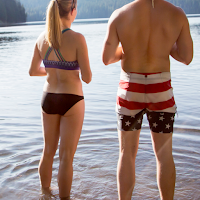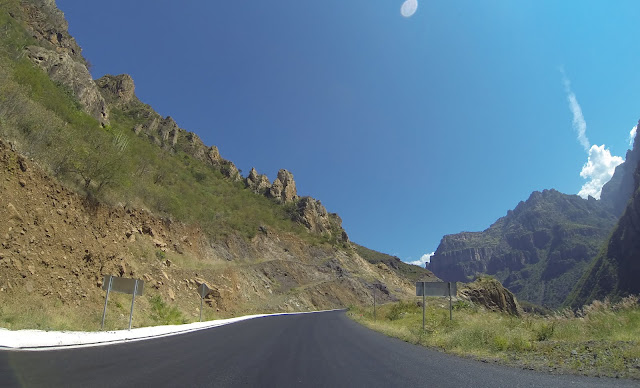The most asked travel question about Mexico is, "Is Mexico safe for travelers?"
 |
| Joaquin 'El Chapo' Guzman Photo:CNN |
Using the words 'Safety' and 'Mexico' in the same sentence is often a treacherous proposition. A quick search of Mexico and Violence will bring up many stories intended to scare the reader and paint a picture that Mexico is a war zone. You can find examples of that here, here, here, and here.
 |
| Mexico is known for its beautiful beaches Photo:Terry Divyak |
Add to that quarterly travel updates from the US State Department. These are easy fodder for fear mongers in the press. One should actually read those travel warnings rather than rely on our very 'accurate' news sources. Here is the link to the current US State Department Travel Advisories for Mexico.
 |
| La Leche Restaurant in Puerto Vallarta |
What does all this mean to the average American traveling in Mexico?
In short, it means travelers into Mexico must not leave their brains and awareness at the border. In nearly all cases, travelers to Mexico are not hurt, targeted or even aware of anything happening until someone informed them.
Safety itself is an illusion. While nothing negative may have ever happened to you, it doesn't predict that evil will forever elude you.
Think about it. Making and trafficking drugs to serve the insatiable appetites of the United States and Canada is a multi-billion dollar a year enterprise. They have no interest in a visitor to their country unless they appear to be a threat to that operation.
Many will point out that there is violence in the United States and Canada with drug gangs and shootouts with police. While this is true, one may not be aware of which areas in Mexico should be avoided, as one would in their home city.
Mexico is a huge country with five distinct regions (Baja California, North, Central, South, and Yucatan Peninsula) The entire continent of Europe can fit into Mexico with plenty of room to spare. Just because one region or area is a hot-spot doesn't mean the rest of the country is in shambles. The USA has Detroit, South Chicago and Washington DC. This doesn't mean the whole country is a disaster.
Whether you are traveling in Mexico, the USA, Canada, Europe, or wherever, it's critical that travelers understand these simple realities and be more aware of their surroundings as a matter of habit.

At any given time over 100,000 travelers are visiting Mexico. Over 99% of them have nothing but a great time a fabulous tan to show for it.
These tips are useful in your own city, country, or really anywhere in the world.
Please look carefully at things you should NOT do in Mexico
- Don't travel at night in Mexico. Especially on backroads but on main highways, too. Cities are usually ok, but be wise. Don't use an ATM or get gas at night. Wait until the following morning. It's best to take a taxi, around town. This advice is especially true if you plan on drinking. Mexico has harsh laws if you cause an accident while intoxicated.
- Avoid doing things you wouldn't do back home. That doesn't mean one should not have fun and enjoy yourself. Have a great time! Just don't be stupid. In Mexico, many activities that are illegal in most of the United States are legal. Prostitution and marijuana possession and use along with drinking alcohol on the beach are all legal in Mexico, but with conditions. Don't be 'that guy' who takes it way too far and winds up in jail. Learn the protocol and where and when to participate, if you are going indulge a little bit.
- Don't be a loudmouth ass. Nobody likes someone like that. Mexicans are particularly tolerant of jerks, but even they can be pushed too far. You'll have a much better time being cool and making friends with the locals.
- Don't try to act like a brave idiot. Unless you're an MMA fighter, don't try to act like one. Don't clip knives to your pocket or talk about tactical training. Nobody likes a wannabe John Rambo.
- Don't flash your money or wealth. This notion should be simple to grasp, but too many people think it's ok to brag about such things. DON'T! You will attract petty criminals who are very experienced at separating you from your cash.
- If a situation seems too good to be true, it probably is. It's easy to be flattered when a beautiful and seductive woman appears to take a fancy to you. Be polite, but be on guard. Many Gringos have their wallets go missing and a serious headache after such encounters.
- Be aware of your surroundings and listen to your inner voice if something seems 'not right.' If your 'spider senses are tingling,' then it's probably best to find another place to be at the time.
- Don't be too curious or nosey. We all know what curiosity does to the cat. It's easy to be mistaken for 'La Policiá' or a rival cartel member if you're where you obviously shouldn't be.
- Don't walk around with headphones on or in your ears. People who do are the easiest to rob in any part of the world.
- Don't keep your wallet, phone, or anything of value in your back pocket. In any busy tourist spot, in the world, these are the easiest ways to be pickpocketed. Pickpocketing is much worse in places like Barcelona, London, NYC, Rio de Janeiro, Paris, and Madrid. It does happen in crowded tourist areas in Mexico. Often a small group of teenage girls flirting or bumping you, somebody feigning an accident or fall, or children crowding, asking for pesos will be how it happens. Pickpocketing and other petty crime is extremely rare in Mexico outside of tourist zones. Don't be paranoid. Mexicans are typically very good and honest people.
- Avoid conversations relating to politics, religion and other divisive topics.
Here are some things to DO when traveling in Mexico.
- Smile, have fun and enjoy yourself. Experience the natural diversity and discover a country rich with beauty, culture, and history that far predates western civilization.
- Pay with Pesos. Mexico is still primarily a cash economy. Unless you have an account at a local Mexican Bank, save your credit cards for special occasions. Typically, $6000MX (currently around $320USD) is a reasonable amount to withdraw from a BANK ATM at one time. That should last you for several days.
- Only keep $400MX-$500MX in your wallet at one time. Preferably $50, $100, and $200 bills. $500MX bills are useful for large purchases like gas or hotel bills, but with smaller vendors they are difficult to change into smaller bills. Stash the bulk of your money in a discreet safe place along with credit or debit cards you won't be regularly using.
- Be respectful and try to learn a little bit of the language. A little effort goes a very long way.
- Go to festivals in the town center. Enjoy the local culture and cuisine. Make friends. Generally speaking, avoid political gatherings.
- Ask the locals for directions or if the route you're planning to take is OK. They may report that the road is out or in terrible condition and suggest a better option.
- Eat at local non-chain restaurants. Just because there is an Applebee's in Mexico doesn't mean you should go there. Visit busy locally owned restaurants and enjoy a unique experience.
- When staying at a hotel or a leaving your car out of sight in a parking lot, look for an attendant. If there is a watchman or a guard on duty, tip them $50MX ($3USD) to keep an eye on your car. These are honorable people who aren't paid very much. Even $50MX goes a long way toward making their lives a little better.
- Carry copies of all of your important documents like passports, driver's licenses, visas, vehicle registration and insurance. Snapping a photo, on your phone is an excellent idea.
- Keep your phone put away. Unless you're making a call or taking a photo, put it away. Mexico is alive. If you're too busy liking Facebook posts and watching YouTube videos you will miss everything good.
- Make sure your mobile phone carrier has you on a plan that includes minutes, data and texting in Mexico. AT&T and T-Mobile have excellent options for this. Check with your carrier.
 |
| Puerto Vallarta at Sunset Photo:Jim Foreman |
Special thanks to Michael Strah for some fine tuning.
Experience the beauty, culture, and history of this great land. It's easy, fun, and surprisingly safe, as long as you're paying attention.
When driving into Mexico, you must have Mexican auto insurance. Choose your best policy from MexicanInsuranceStore.com. It's as simple as Choose, Buy, and Print.
©2022 Jim Foreman All Rights Reserved















 When in Rome, do as the Romans do. -
When in Rome, do as the Romans do. -
























